Mississippi contains a rich history that showcases its natural beauty and importance to the development of the United States. After all, the Magnolia State gets its nickname from the magnolia flower, which grows throughout the state. Many other plants and animals call the state home, including mockingbirds and alligators. The state is also home to many species of spiders, such as orb weavers and wolf spiders. Here is a list of 10 spiders in Mississippi that you can find throughout the Magnolia State.
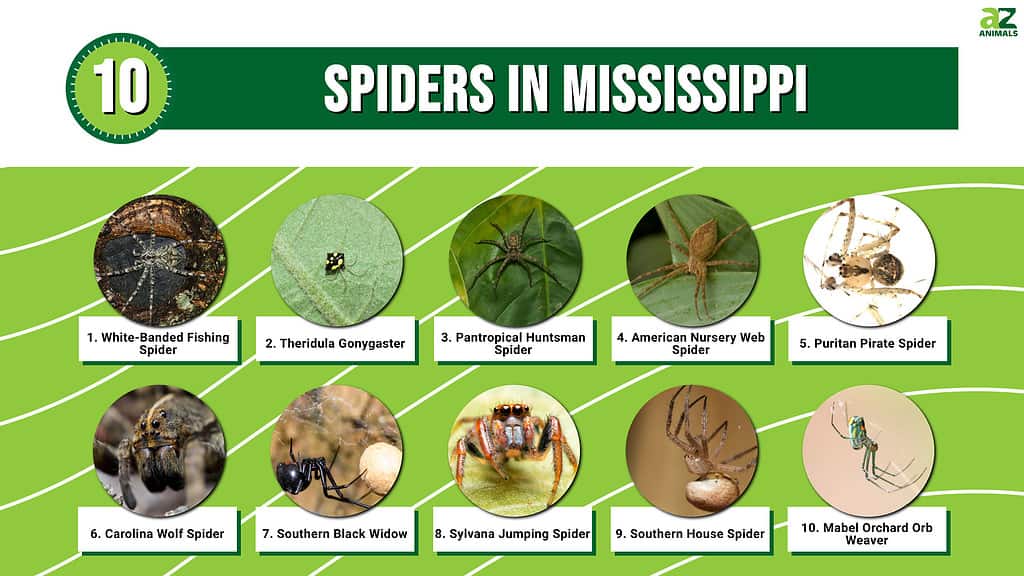
The white-banded fishing spider, puritan pirate spider, and sylvana jumping spider are spiders found in Mississippi.
©
#10. Mabel Orchard Orb Weaver
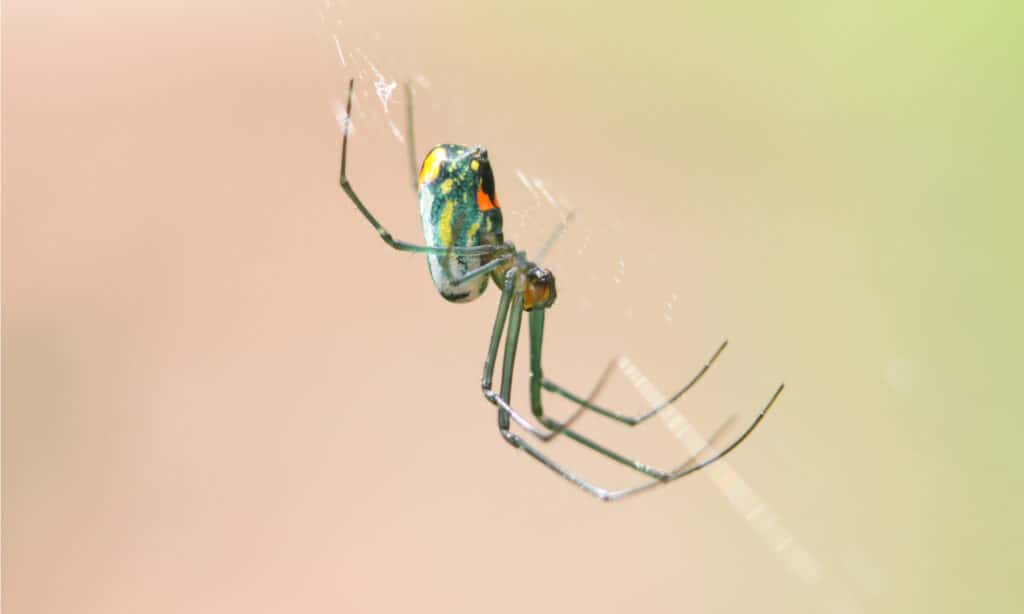
The Mabel orchard orb weaver was named by Charles Darwin.
©MJANaturePics/Shutterstock.com
The Mabel orchard orb weaver, Leucauge argyrobapta, belongs to the long-jawed orb weaver family Tetragnathidae. You can find these colorful spiders in Mississippi as well as throughout the United States and as far south as Brazil.
Female Mabel orchard orb weavers measure 5.5 to 7.5 millimeters long, while males measure 3.5 to 4 millimeters long. Like other long-jawed orb weavers, they possess long, thin legs and large mouthparts. Their legs appear green with black bands, while the cephalothorax is tan. In Greek, argyrobapta translates roughly to “dipped in silver,” which refers to their silvery abdomen that features orangish-red markings and yellow, black, and green stripes.
The Mabel orchard orb weaver is the only spider species named by Charles Darwin. It typically constructs a horizontally-oriented web that it uses to catch insects, including mosquitoes. When feeding, it pumps digestive enzymes into its prey to break down the body.
#9. Southern House Spider
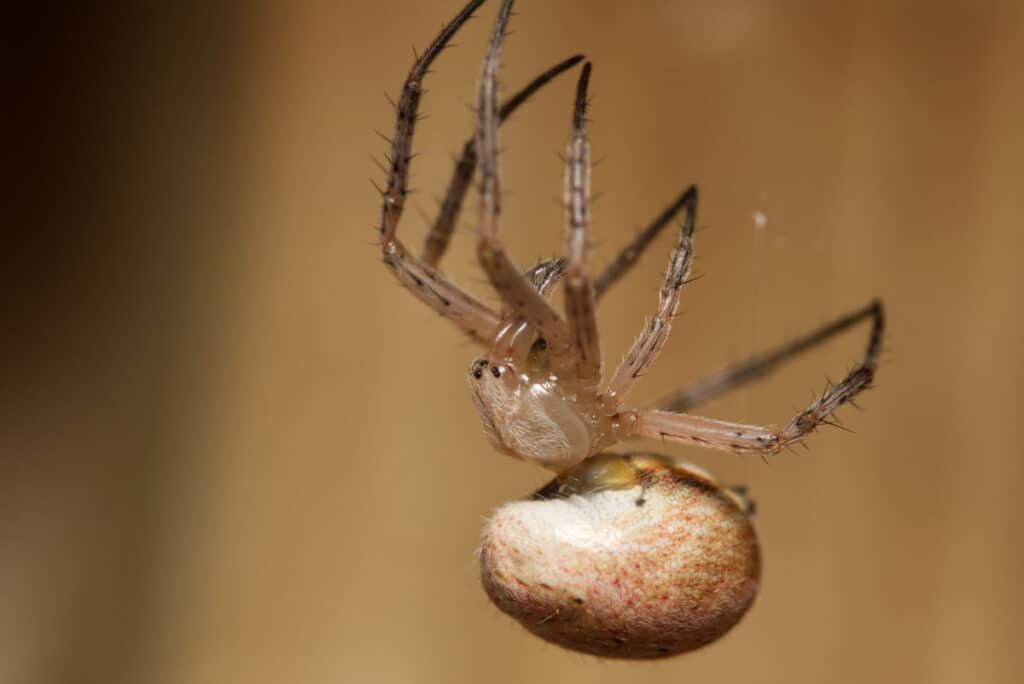
Southern house spiders often get mistaken for brown recluses due to their similar markings.
©Kala Stuwe/Shutterstock.com
The southern house spider, Kukulcania hibernalis, is one of the most common spiders in Mississippi. As its name implies, it ranges throughout the southern United States as well as the Caribbean and South America.
Adult southern house spiders measure about 5 centimeters long with their legs extended. Unlike many species that display sexual dimorphism, male and female southern house spiders measure about the same size. However, males tend to possess longer legs, while females grow larger bodies. Both males and females typically appear predominantly brown, with males looking lighter than females.
Southern house spiders construct radial-style webs made of non-sticky threads that they use to ensnare prey. They rarely act aggressively toward humans, and their bite is not medically significant.
#8. Sylvana Jumping Spider

The sylvana jumping spider is an arboreal species named after the Roman god Sylvanus.
©Sari ONeal/Shutterstock.com
Colonus sylvanus, or the sylvana jumping spider, is a member of the jumping spider family Salticidae. You can find these spiders in Mississippi as well as throughout the eastern United States and as far south as Panama.
Adult sylvana jumping spiders typically measure 7.5 millimeters long or less, with females measuring longer than males. They predominantly come in two different morphs. One morph looks tan with a cream abdomen covered in reddish spots. The other morph possesses a reddish-brown cephalothorax and a brown abdomen with two white lines down the center.
Sylvana jumping spiders tend to hang out in trees and are likely arboreal. Their name comes from silva, or “forest” in Latin, as well as Sylvanus, the Roman god of woodlands. They hunt by jumping from a distance and ambushing insects and other spiders. Due to their small size, they pose no danger to humans.
#7. Southern Black Widow

The southern black widow possesses venom that affects its prey’s nervous system.
©Jeff W. Jarrett/Shutterstock.com
The southern black widow, Latrodectus mactans, is one of the most venomous spiders in Mississippi. A member of the cobweb spider family Theridiidae, the southern black widow ranges throughout North America but most predominantly in the southern United States.
Adult females measure from 8 to 13 millimeters long, while males measure between 3 and 6 millimeters long. They have relatively long legs. Females look shiny and black and feature a distinctive red hourglass-shaped marking on the top of the abdomen.
Female southern black widows construct three-dimensional cobwebs made of strong silk that they use to capture prey. On occasion, they will cannibalize male spiders after mating, which is why they go by the name widow spiders. Their bite is medically significant and attacks the victim’s nervous system. Common symptoms of bites include muscle aches, nausea, and respiratory issues.
#6. Carolina Wolf Spider
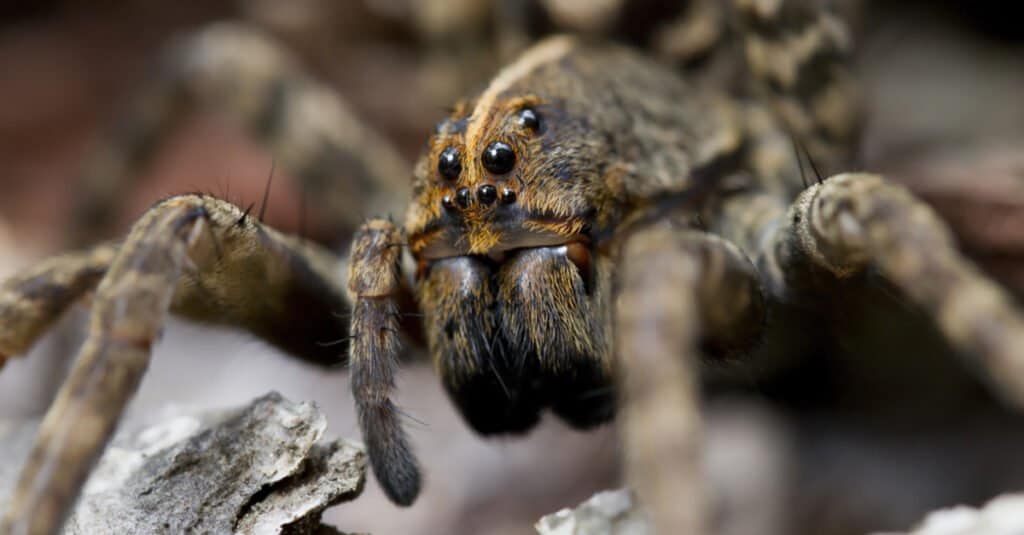
The Carolina wolf spider can reach nearly 50 millimeters long with its legs extended.
©Will E. Davis/Shutterstock.com
The Carolina wolf spider, Hogna carolinensis, belongs to the wolf spider family Lycosidae. It is not only the largest of all the wolf spiders in Mississippi but also the largest throughout North America.
Female Carolina wolf spiders measure from 22 to 35 millimeters long, while males measure 18 to 20 millimeters long. These spiders appear predominantly light brown but also feature several darker brown markings. Additionally, males possess orange coloration on their sides. During the incubation period, females carry their egg sacs on top of their spinnerets.
Carolina wolf spiders do not use webs to capture prey. Instead, they hunt by ambushing prey from burrows that they construct in the ground. They possess unique venom that can simultaneously paralyze and disinfect their prey. Despite their venom and large size, their bite poses little danger to humans.
#5. Puritan Pirate Spider

The puritan pirate spider kills other spiders and steals their webs
©Gergin Blagoev, Centre for Biodiversity Genomics / CC0, via Wikimedia Commons – License
Mimetus puritanus, or the puritan pirate spider, belongs to the pirate spider family Mimetidae. It is one of the most unusual spiders in Mississippi in that it predominantly preys on other spiders. It ranges throughout much of the eastern United States.
Adult specimens generally measure about 7 millimeters long, with males measuring smaller than females. They possess triangular-shaped abdomens and spines on their long, curved legs. While they appear mostly tan or beige, they also sport small red and black markings and two characteristic white patches near the rear of the abdomen.
As their name implies, puritan pirate spiders do not build their own webs. On the contrary, they are notorious for stealing the webs of other spiders. Although they attack and eat other spiders, they occasionally underestimate their prey and end up getting eaten by their intended victims. Their bite is not considered threatening to humans.
#4. American Nursery Web Spider
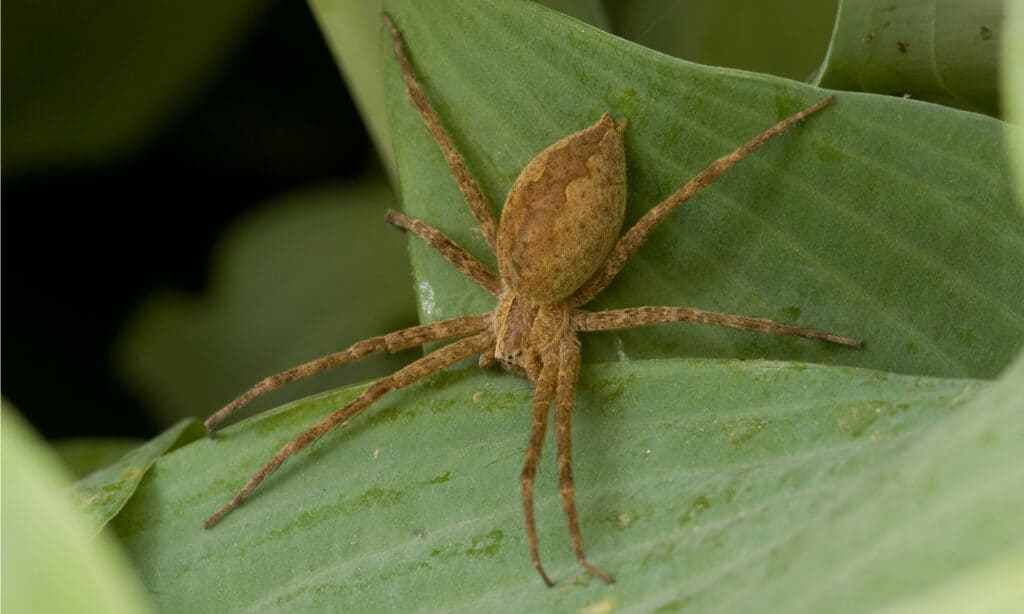
Male American nursery web spiders will tie up females’ legs during mating to avoid being eaten afterward.
©SDeming/Shutterstock.com
The American nursery web spider, Pisaurina mira, belongs to the nursery web spider family Pisauridae. You can normally find these spiders in Mississippi in areas with high weeds or shrubs. In addition, they range throughout the eastern half of North America.
Adult American nursery web spiders can grow up to 19 millimeters long, with males measuring smaller than females. They typically have tan or brownish bodies in addition to very long legs. On occasion, people mistake them for brown recluse spiders due to their similar appearance.
As their name implies, American nursery web spiders build webs to hold their eggs. However, they do not use their webs to capture prey. Instead, they actively hunt insects using sit-and-wait ambush tactics. Females also often cannibalize males shortly after mating. To avoid being eaten, males evolved a habit of binding females’ legs with silk. Their bite is not medically significant.
#3. Pantropical Huntsman Spider
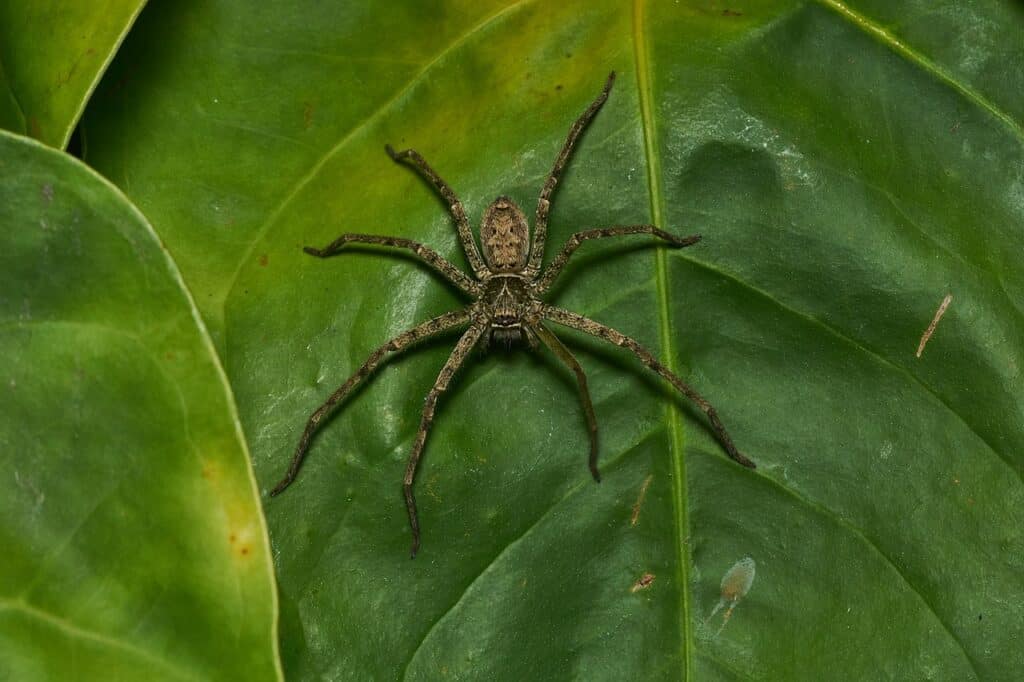
Pantropical huntsman spiders can measure nearly 12 centimeters long with their legs extended.
©© 2017 Jee & Rani Nature Photography / CC BY-SA 4.0 via Wikimedia Commons – License
Heteropoda venatoria, or the pantropical huntsman spider, is a member of the family Sparassidae. They also go by the name giant crab spiders or cane spiders. While originally native to Asia, you can find these spiders in Mississippi as well as throughout the southern United States.
Adult pantropical huntsman spiders measure between 22 and 28 millimeters long. That said, they can measure up to 12 centimeters long with their legs extended. Females tend to measure larger than males, although males have longer legs than females. They appear predominantly tan or cream, while males feature a dark stripe down the center of their abdomen.
Pantropical huntsman spiders do not build webs to capture prey and instead rely on their speed and strength to capture insects. While they can deliver painful bites, they are not otherwise dangerous.
#2. Theridula Gonygaster
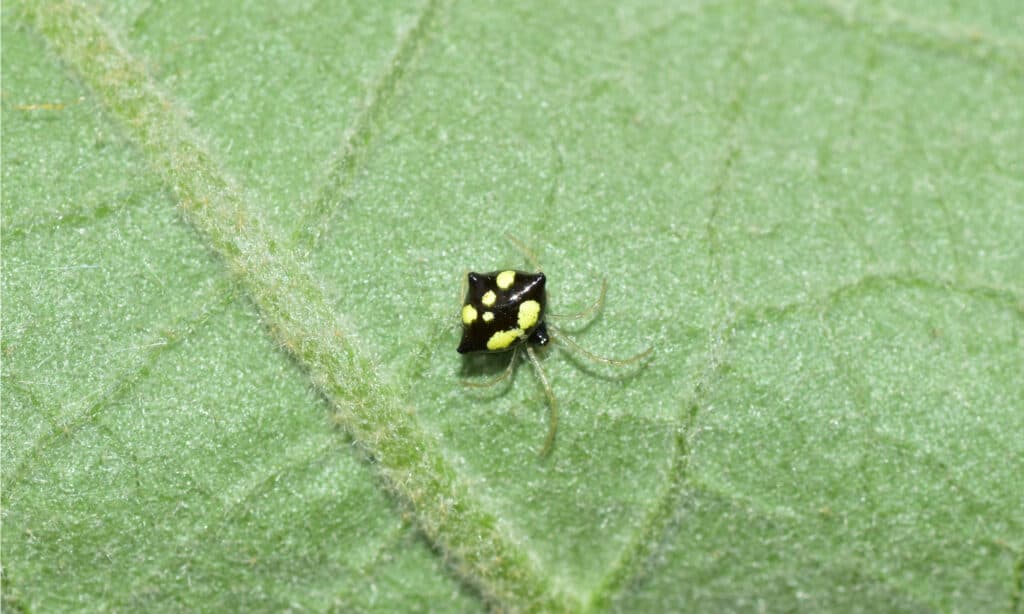
is a tiny species that measures no more than 3.5 millimeters long.
©Nandani Bridglal/Shutterstock.com
Theridula gonygaster is the second member of the family Theridiidae to make our list of spiders in Mississippi. This tiny cobweb spider is originally native to the Americas but now ranges throughout parts of southern Europe, Africa, China, and Japan. Like most lesser well-known spiders, Theridla gonygaster does not have a common name and goes only by its scientific name.
Adult females measure 3 to 3.5 millimeters long, while males measure 1.3 to 1.7 millimeters long. They have skinny legs and bulbous, diamond-shaped bodies. Males typically appear yellow-white with dark markings, while females appear black with white or yellow dots.
Theridula gonygaster constructs a tangled cobweb that it uses to catch its prey. Due to its small size, it poses no threat to humans.
#1. White-Banded Fishing Spider
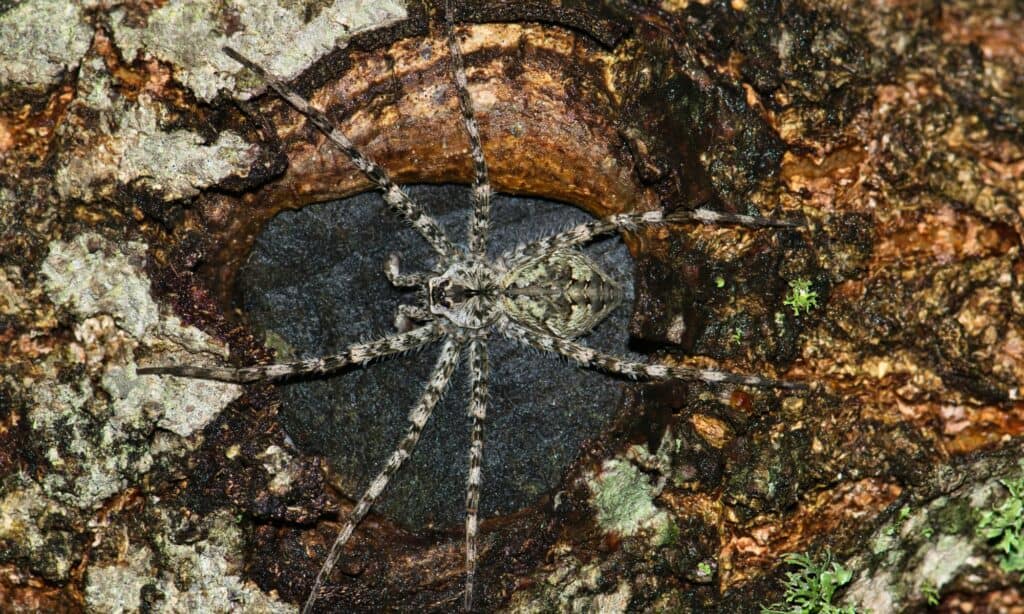
The white-banded fishing spider can create an air pocket under its abdomen that allows it to dive under the water to catch prey.
©iStock.com/Brett_Hondow
Like the American nursery web spider, the white-banded fishing spider, Dolomedes albineus, is a member of the family Pisauridae. However, it belongs to a different genus, Dolomedes, also known as fishing spiders.
Adult females can measure up to 23 millimeters long, and males can reach up to 18 millimeters long. While they vary in color, they usually appear brown or mossy green with dark markings. They get their name from the white band that runs across the space below their eyes. Sometimes, this line wraps around the jaws and around the entire carapace.
White-banded fishing spiders do not use webs to catch prey. As their name implies, they fish for insects and small fish using their legs as fishing rods. They can also run across the surface of the water or dive under the surface. Despite their large size, their bite is not medically significant.
Summary of 10 Spiders in Mississippi
Here’s a recap of the 10 spiders present in the state of Mississippi that we took a look at.
| Number | Spider | Scientific Name | Fun Fact |
|---|---|---|---|
| 1 | White-Banded Fishing Spider | Dolomedes albineus | These spiders fish for insects and small fish using their legs as fishing rods. |
| 2 | Theridula Gonygaster | Theridula Gonygaster | Like most lesser well-known spiders, this species does not have a common name. |
| 3 | Pantropical Huntsman Spider | Heteropoda venatoria | These spiders do not build webs to capture prey but instead rely on speed and strength to hunt insects. |
| 4 | American Nursery Web Spider | Pisaurina mira | To avoid being eaten after mating, males evolved a habit of binding females’ legs with silk. |
| 5 | Puritan Pirate Spider | Mimetus puritanus | This most unusual spider preys on other spiders, killing them and stealing their webs. |
| 6 | Carolina Wolf Spider | Hogna carolinensis | These spiders possess unique venom that can simultaneously paralyze and disinfect their prey. |
| 7 | Southern Black Widow | Latrodectus mactans | On occasion, females will cannibalize males after mating. |
| 8 | Sylvana Jumping Spider | Colonus sylvanus | This spider’s name comes from silva, or “forest” in Latin, as well as Sylvanus, the Roman god of woodlands. |
| 9 | Southern House Spider | Kukulcania hibernalis | Unlike many species that display sexual dimorphism, males and females measure about the same size. |
| 10 | Mabel Orchard Orb Weaver | Leucauge argyrobapta | This is the only spider species named by Charles Darwin. |
The photo featured at the top of this post is © iSKYDANCER/Shutterstock.com
FAQs (Frequently Asked Questions)
What are the most dangerous spiders in Mississippi??
The four most dangerous spiders in Mississippi are the northern yellow sac spider, the brown and black widows, and the brown recluse.
Thank you for reading! Have some feedback for us? Contact the AZ Animals editorial team.






